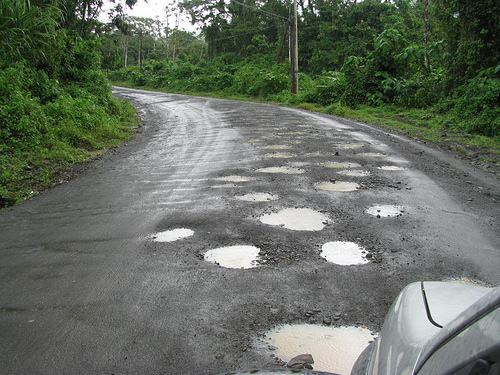Costa Rica News – For all of you that have had the lovely experience of attempting to drive in Costa Rica this article is for you. While in Costa Rica, you may find road conditions that differ significantly from those in the United States. The Costa Rican Times has provided the following report about Costa Rican roads and road safety for your reference:
 Roads are often in poor condition. Large potholes with the potential to cause significant damage to vehicles are common. Traffic signs, even on major highways, are inadequate and few roads have clearly marked lanes. Except for the principal highways, few roads have names, making it difficult to find addresses.
Roads are often in poor condition. Large potholes with the potential to cause significant damage to vehicles are common. Traffic signs, even on major highways, are inadequate and few roads have clearly marked lanes. Except for the principal highways, few roads have names, making it difficult to find addresses.
Shoulders are narrow or consist of drainage ditches. Visibility at intersections is often limited by hedges or other obstacles. Bridges, even on heavily traveled roads, may be only a single lane requiring vehicles traveling in one direction to cede the right of way to oncoming vehicles. Pedestrians, cyclists, and farm animals are common sights along or on main roads, creating additional potential driving hazards. Buses and cars frequently stop in travel lanes, even on expressways.
Traffic laws and speed limits are often ignored, turn signals are rarely used, passing on dangerous stretches of highway is common, and pedestrians are not given the right of way. The copious motorcyclists in particular, drive without respect to rules of the road, often passing on the right, weaving in and out without warning, and creating lanes where none officially exist. As a result, the fatality rate for pedestrians and those riding bicycles and motorcycles is disproportionately high. All of the above, in addition to poor visibility due to heavy fog or rain, can make driving treacherous. Landslides are common in the rainy season. Main highways and principal roads in the major cities are paved, but some roads to beaches and other rural locations are not.
Moreover, rural roads sometimes lack bridges and motorists are compelled to ford waterways; you should exercise extreme caution in driving across moving water, as a small trickle in the dry season may become a strong torrent after a heavy rain upstream. Even a few inches of moving water may be sufficient to float your vehicle, and the river bed may not be stable.
In order to drive in Costa Rica, drivers need to show a valid U.S. driver’s license or an international driving permit. Drunk driving is illegal in Costa Rica. There are individuals who drive while using their cell phone but anything that impedes one’s ability to drive is discouraged.
Many destinations are accessible only with high clearance, four-wheel drive vehicles. When staying outside of urban areas, travelers should call ahead to their hotels to ask about the current status of access roads. Travelers should also minimize driving at night, especially outside of urban areas.
Costa Rica has a 911 system for reporting emergencies. In the event of a traffic accident, vehicles must be left where they are and should not be moved from where the accident occurred. Both the traffic police and an insurance investigator must make accident reports before the vehicles are moved.
Drive safely in Costa Rica or wherever you are!

